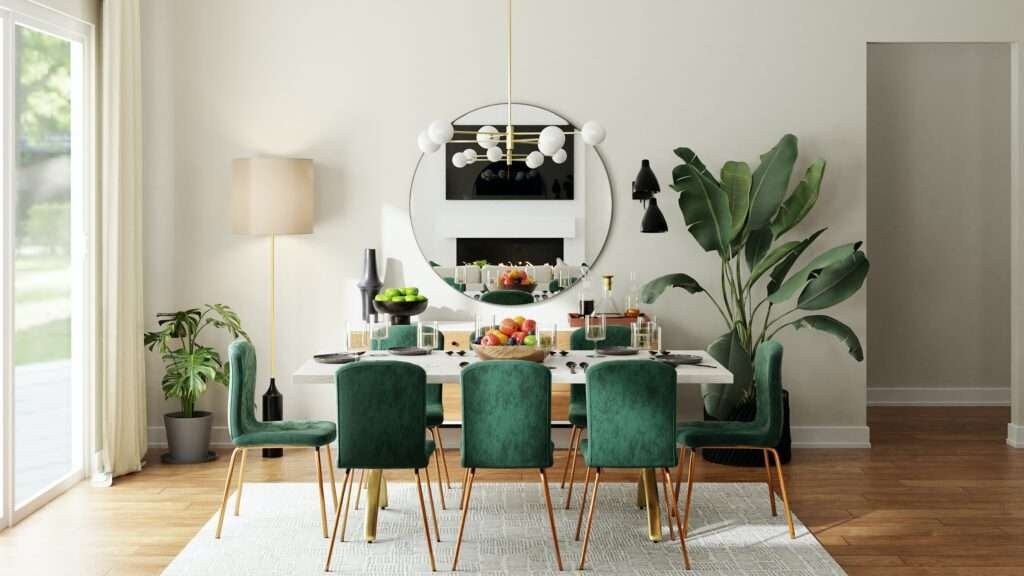vastu for Dining room

In the realm of Vastu for dining room, the ancient Indian science of architecture and design, every corner of a home holds the potential to influence the well-being and energy of its occupants.
The dining room, where families gather to share meals and build connections, is a vital space that can benefit immensely from Vastu principles. By aligning your dining room with these principles, you can create a harmonious and nourishing environment for both your loved ones and your own well-being.
Let’s explore some friendly and informative insights on Vastu for dining rooms to help you design a space that fosters positive energies and enriching experiences.
1. Ideal Location:
The dining room is best located in the western or eastern part of your home. The eastern direction is associated with the rising sun and symbolizes new beginnings, while the western direction is related to the setting sun and encourages a sense of completion and fulfillment.
Placing the dining room in either of these directions can infuse the space with vibrant energies that enhance the dining experience.
2. Shape and Layout:
Opt for a square or rectangular dining table whenever possible, as these shapes are harmonious and symbolize unity and togetherness.
Ensure that the table is proportionate to the room’s size, allowing comfortable movement around it. Avoid irregularly shaped or excessively large tables that may disrupt the flow of energy.
3. Positioning the Dining Table:
Place the dining table in the center of the room, ensuring equal space on all sides. This promotes balance and harmony during meals. Avoid positioning the table against a wall or corner, as this can create a sense of confinement.
Ideally, all family members should have a clear view of the main entrance while seated at the table.
4. Lighting Matters:
Ample natural light is beneficial for the dining room. Position windows to allow the flow of fresh air and sunlight during mealtimes.
Supplement natural light with gentle and warm artificial lighting to create a welcoming ambiance during evening meals.
5. Color Palette:
Opt for soothing and earthy colors for the dining room walls, such as shades of green, beige, or soft yellow. These colors evoke a sense of nourishment and comfort, enhancing the dining experience.
Avoid overly bright or bold colors that may lead to restlessness or distraction.
6. Mirror Placement:
Strategically place a mirror on the dining room wall, reflecting the dining table. Mirrors amplify energy and symbolize abundance.
Ensure that the mirror reflects a clean and well-arranged dining space, as this can multiply the positive vibrations.
7. Seating Arrangement:
The head of the family should ideally sit facing east or west, while other family members can sit facing north or east. This arrangement is believed to enhance positive interactions and digestion.
Avoid sitting under a beam or directly facing a door, as this can create discomfort.
8. Storage and Clutter:
Keep the dining room clutter-free and organized. Adequate storage for utensils, crockery, and cutlery is essential. Clutter can disrupt the flow of energy and create a chaotic atmosphere, hindering the dining experience.
9. Art and Decor:
Adorn the dining room with meaningful and uplifting artwork or decor items. Paintings or sculptures depicting abundance, nourishment, or joy can enhance the room’s positive energy.
Fresh flowers or indoor plants can also contribute to a vibrant atmosphere.
10. Food Placement:
While dining, avoid placing leftover food or empty plates on the dining table for an extended period. Clear the table promptly after meals to prevent stagnant energy and promote a sense of cleanliness.
11. Electronic Devices:
Minimize the presence of electronic devices, such as TVs or phones, in the dining room. These distractions can hinder meaningful conversations and disrupt the dining experience.
12. Symbolic Enhancements:
Consider incorporating Vastu symbols or artifacts like a small water fountain or a representation of the ‘Annapurna’ deity, who is associated with nourishment.
These additions can infuse the space with positive energies related to abundance and fulfillment.
By integrating these Vastu for dining room principle, you can create a space that not only facilitates nourishing meals but also fosters strong connections and positive energies among family members.
Remember, while Vastu provides valuable insights, it’s essential to prioritize the comfort, unity, and well-being of your family members above all else.
Striking a balance between Vastu guidelines and your personal preferences can lead to a dining room that resonates with harmony and fulfillment.
read vastu in Wikipedia
- Vastu for dining room is a crucial aspect of harmonious living, as it’s where families come together to share meals and connect.
- According to Vastu principles, the ideal location for the dining room is often in the west or northwest direction of the house.
- To promote a sense of togetherness and abundance, Vastu for dining room suggests using warm, inviting colors like earthy tones or soft yellows.
- Ensure that the dining table is positioned so that family members face east or north while eating, harnessing the positive energies associated with these directions.
- Vastu for dining room also emphasizes the importance of cleanliness and tidiness to maintain a positive energy flow during meals.
- Mirrors in the dining room, according to Vastu, can double the food on the table, symbolizing abundance and prosperity.
- Lighting plays a crucial role in Vastu for dining room; opt for soft, diffused lighting to create a warm and welcoming atmosphere.
- Avoid placing the dining area adjacent to a bathroom or under a staircase, as these placements are considered inauspicious in Vastu.
- Incorporating natural elements, such as wooden furniture or potted plants, can enhance the connection to nature and promote a sense of well-being in the vastu for dining room.
- By following Vastu for dining room principles, you can not only improve the energy of your meals but also strengthen family bonds and create a nurturing environment for gatherings.
